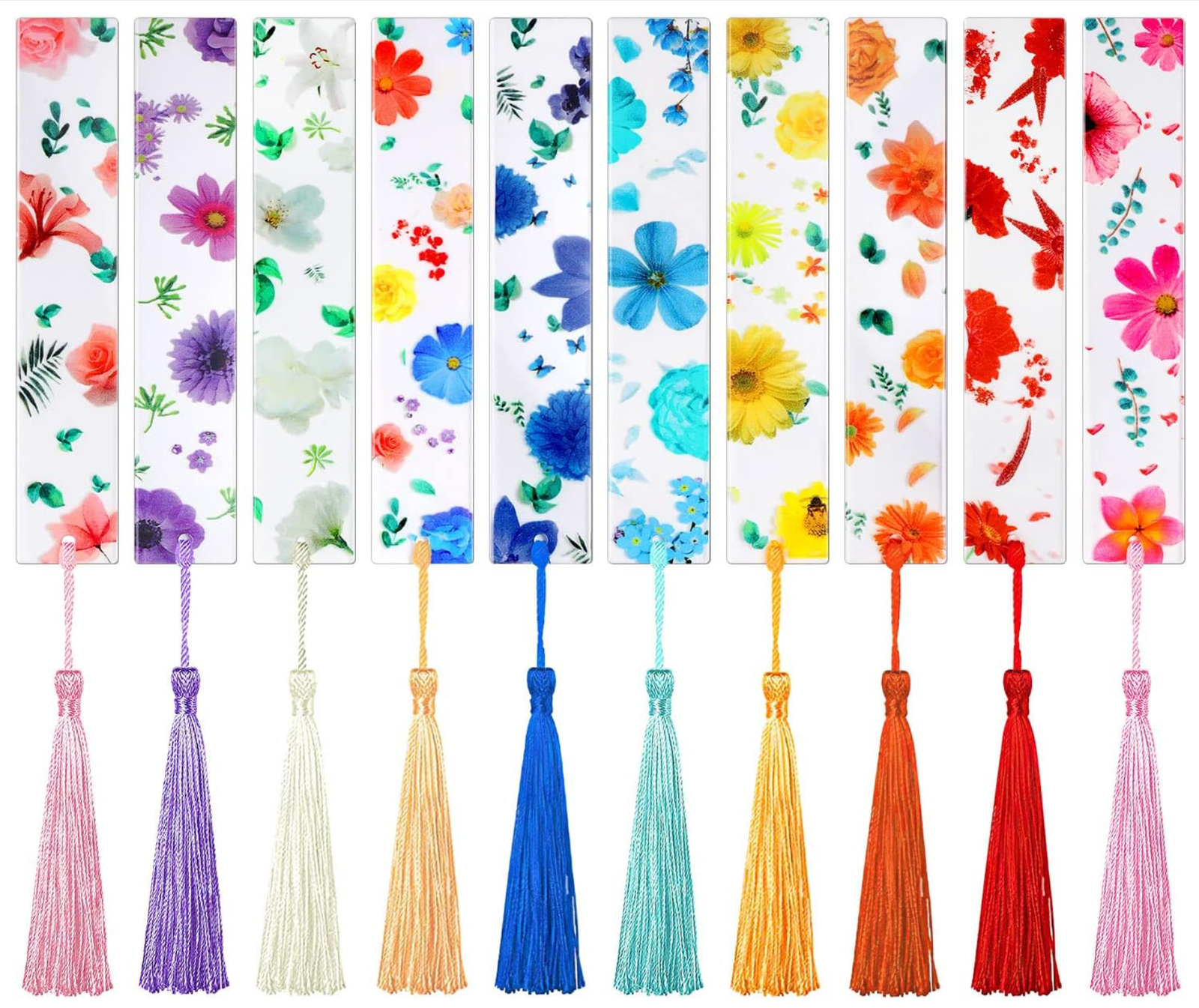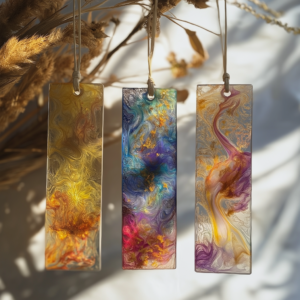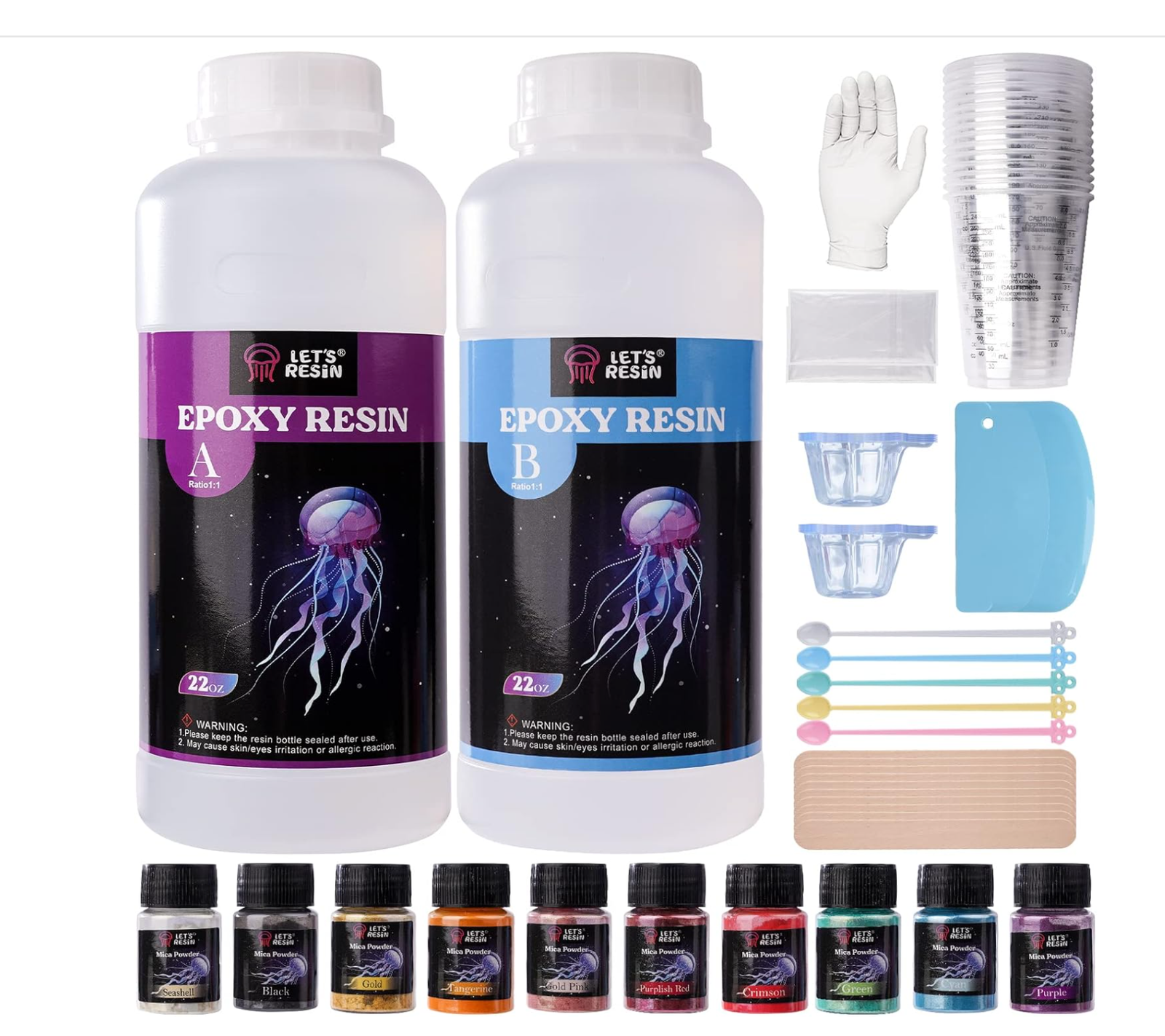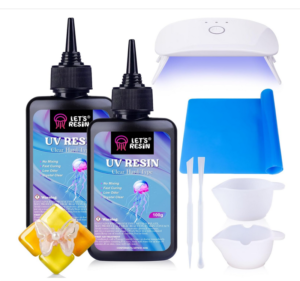Which Resin is Best for Making Bookmarks? A Guide for Crafte…

10 Pieces Flower Resin Bookmark on Amazon Material has actually rapidly gotten appeal when crafting personalized book markings as a result of its countless creative opportunities. Resin book marks offer a creative canvas to embed various components, such as blossoms, leaves, shine, and even intricate beauties. The resulting book marks have a classy, glossy finish that preserves the ingrained items and includes an one-of-a-kind touch to the analysis experience. Nonetheless, picking the appropriate material for this task can be daunting. From differences in treating times to variants in longevity and flexibility, picking the most suitable material is important for accomplishing the desired outcomes. With the right choice, you can make book markings that are beautiful and resilient.
In this thorough overview, we intend to navigate via the myriad of resin alternatives offered. Whether you’re brand-new to material crafting or a skilled professional wanting to fine-tune your abilities, we’ll aid you select the material that ideal suits your needs for bookmark-making. By comprehending the features of different resins, you’ll be fully equipped to develop visually fascinating and functional items.
What is A Resin?
Resin is a synthetic or natural material that typically starts in fluid kind and strengthens through a chemical reaction referred to as curing. It can be made from plant-based products like tree sap or manufactured in laboratories to generate different materials, including epoxy, polyurethane, and polyester. Due to their adaptability and toughness, resins are extensively made use of in crafting, commercial applications, and art.
When combined with a setting agent, the material transforms into a challenging, plastic-like material that can have either a matte or glossy look, relying on the specific additives and kind of resin made use of. Material is particularly preferred for tasks like precious jewelry, coatings, and bookmarks, as it can be built into various forms and utilized to frame decorative elements.
Sorts of Resin: The Basics
Resin crafting has evolved into a detailed art type, and understanding the types of material offered is the primary step toward mastering this craft. The material is a type of polymer that changes from a liquid to a solid state, commonly because of a chain reaction in between 2 elements: the material and a hardener. The fluid material hardens into a long lasting, plastic-like product throughout the healing process. This solidified type can lead to different finishes, from a glossy, clear look to an extra opaque or displayed appearance.
The kind of resin you choose influences the last appearance of your book marks and the ease with which you can work. For example, some resins cure faster than others, and some are extra susceptible to yellowing when exposed to sunlight. Grasping these distinctions is crucial for getting optimum outcomes, as different resin types come with their own one-of-a-kind advantages and downsides. This section will certainly discover the most typical resin kinds and what makes them optimal for book mark crafting.
Epoxy Resin: The All-Rounder

 Thanks to its flexibility and simplicity of use, epoxy resin has long been a favorite among DIY crafters and specialist artists alike. Whether you’re a beginner explore resin for a skilled artist or the initial time crafting intricate layouts, epoxy material gives a versatile structure. It’s a dual-component system that blends resin and harden to launch healing. The result is a durable, crystal-clear book marking that’s not only lovely yet practical also.
Thanks to its flexibility and simplicity of use, epoxy resin has long been a favorite among DIY crafters and specialist artists alike. Whether you’re a beginner explore resin for a skilled artist or the initial time crafting intricate layouts, epoxy material gives a versatile structure. It’s a dual-component system that blends resin and harden to launch healing. The result is a durable, crystal-clear book marking that’s not only lovely yet practical also.
Epoxy resin attracts attention in book mark crafting since it offers sufficient functioning time, enabling cautious positioning of embedded products like blossoms, radiance, or appeals. Its high-gloss finish makes it perfect for tasks where a beautiful, sleek look is essential. One downside to epoxy resin is its tendency to yellow when revealed to sunshine, though several modern-day formulas come with UV inhibitors that slow down this process. It’s additionally worth keeping in mind that epoxy resin takes longer to treat fully, requiring approximately 48 hours for a solid finish.
For those simply starting, epoxy material is an accessible choice that uses excellent results. With practice, you’ll learn how to avoid bubbles, make sure even blending, and master the art of producing stunning, customized book markings.
.
Advantages of Epoxy Resin for Bookmarks:
[caption id="attachment_184" align="alignleft" width="500"] < map wp-tag-caption id =" attachment_184" align=" alignleft" size =" 500"
< map wp-tag-caption id =" attachment_184" align=" alignleft" size =" 500"
/ wp-end-tag >< img class=" wp-image-184 "title= “LET’S RESIN Epoxy Resin Kit on Amazon “src=” https://drippyart.com/wp-content/uploads/2024/09/afbeelding_2024-10-28_133218275.png” alt= “LET’S RESIN Epoxy Resin Kit on Amazon “width =” 500″ height =” 444″/ > LET’S RESIN Epoxy Resin Kit on Amazon Crystal Clear Finish: Epoxy
material’s essential feature is its capability to harden right into a smooth, clear, and glossy surface.This makes it suitable for book marks with vital visual components. User-Friendly: Epoxy resin usually has a longer working time than other resins, offering you lots of time to pour,
mix, and readjust before it begins to treat. Budget friendly: Epoxy resin is widely readily available and typically extra inexpensive than other specialty materials, making it a best option for newbie crafters.
Solid and Durable: Once treated, epoxy resin produces a durable and durable book mark that can hold up against day-to-day usage without shedding its kind.
Drawbacks:
Yellowing Over Time: Although many brand names provide UV-resistant epoxy material, it is still at risk to yellowing with time, particularly when revealed to sunshine for extensive periods.
Lengthy Cure Time: Epoxy material generally takes around 24-48 hours to heal completely, which might be bothersome if you’re working on several book markings and need quick turnover.
Finest Epoxy Resins for Bookmarks:
LET’S RESIN Epoxy Resin Kit: This package has epoxy material, color pigments, shine and molds, and is optimal for newbies.
ArtResin: Known for its non-toxic, high-gloss finish, ArtResin is excellent for crafters trying to find exceptional high quality.
JANCHUN Epoxy Resin Kit – Includes epoxy material, pigments, mixing gloves and sticks. The package has great reviews and offers a smooth finish.
UV Resin: The Speedy Option
UV resin has come to be increasingly prominent, particularly among crafters, because it is simple to use and offers rapid outcomes. Unlike epoxy resin, which needs mixing 2 elements, UV resin is a single-component product that remedies ultraviolet light in just a couple of minutes. This rapid treating process makes it specifically appealing for time-sensitive projects or for those who intend to craft several bookmarks in one sitting.
UV resin’s fast treating time is a substantial advantage for making book markings. With UV light, your bookmark can be ready to use in simply a couple of minutes. Since it cures so quick, you’ll need to work swiftly when installing products or changing styles. Its reduced viscosity likewise indicates it flows quickly right into mold and mildews, catching fine details without the need for excessive modifications. In spite of its speed, UV material does not have the long-lasting toughness of epoxy, particularly when exposed to direct sunlight for prolonged periods.
The compromise in between rate and longevity is something to take into consideration. UV material might be best fit for enthusiasts or those developing bookmarks for occasional usage. It’s much less suitable for high-traffic book markings that will be regularly subjected to the elements. No matter, it’s an amazing option for hectic tasks that call for prompt outcomes.
Benefits of UV Resin for Bookmarks:

 Fast Curing: The primary advantage of UV resin is its very rapid curing time. When placed under a UV light, it can set in just a couple of mins, allowing you to finish your task in no time. Low Viscosity: UV resin often tends to be thinner than epoxy, making pouring right into fine molds or adding elaborate details to your book markings easier. No Mixing Required: UV material is a single-component
Fast Curing: The primary advantage of UV resin is its very rapid curing time. When placed under a UV light, it can set in just a couple of mins, allowing you to finish your task in no time. Low Viscosity: UV resin often tends to be thinner than epoxy, making pouring right into fine molds or adding elaborate details to your book markings easier. No Mixing Required: UV material is a single-component
material, suggesting you do not have to blend two parts with each other, minimizing the threat of mistakes in the blending process. Drawbacks: Requires UV Light: Unlike epoxy resin, which remedies naturally with time
, UV resin needs a UV light
to cure properly. Without one, the resin will not solidify. Smaller Working Time: Because it cures so promptly, you’ll need to work fast when pouring and installing things right into your material bookmark mold. Much Less Durability: UV resin tends to be less sturdy with time than epoxy, specifically when subjected to continuous sunshine. Best UV Resins for Bookmarks: LET’S RESIN UV Resin Kit -This kit consists of UV material, a
UV light, and commonly pigments and glitters. The material remedies swiftly under UV light, which is ideal for smaller tasks like book marks
. DecorRom UV Resin Kit -Comes with
- UV material, pigments, a small UV lamp, and accessories. DecorRom is known for premium material that remedies clear and is sturdy. Jdiction UV Resin Kit- This package consists of high quality UV resin that withstands yellowing,
- in addition to a UV lamp, mixing tools, and accessories to include designs to book marks. Limino UV Resin: Known for its reduced odor and non-toxic formula, this is a wonderful selection for tiny crafting tasks
- like book markings. Polyester Resin: The Professional’s Choice Polyester material is commonly the go-to choice for crafters that require an even more professional coating. This industrial-grade resin uses a hard, glass-like surface area that stands up to heavy use while keeping dazzling clarity. Polyester resin is an exceptional alternative if you’re going for a high-grade, sleek book marking that appears like
something you would certainly find in a premium store. Among polyester material’s largest benefits is its resistance to yellowing. This makes it ideal for book markings that will be subjected to sunlight or made use of frequently. Its ultra-clear surface showcases ingrained components perfectly, making it a favored amongst artists who want to highlight elaborate designs or delicate things like dried out blossoms. Polyester resin has a steeper discovering curve than epoxy or UV resins. The fumes it releases throughout treating can be hazardous, calling for a well-ventilated work space
and appropriate safety tools. Additionally, polyester resin treatments more quickly than epoxy however has a much shorter shift, which may challenge beginners. When mixed with its driver, it solidifies within mins, leaving little area for changes. In spite of these downsides, its high-gloss finish and longevity make it the favored selection for sophisticated crafters that wish to create professional-quality book marks. Benefits of Polyester Resin for Bookmarks: High Durability: Polyester material is exceptionally solid and can resist scratches and influences
better than lots of other materials. Shiny Finish: Once healed, it has a high-gloss, glass-like finish that is incredibly smooth and shiny. Immune to Yellowing: Unlike epoxy resin, polyester material is more resistant to UV light and is much less most likely to yellow gradually. Disadvantages: Toxic Fumes: Polyester material generates strong fumes during treating, so it has to be used in a well-ventilated area with appropriate safety equipment
. Brief Working Time: Once the stimulant is added, polyester resin has an extremely short functioning home window, making it a lot more challenging for beginners. More Difficult to Work With: Polyester resin is normally harder to make use of due to its complex blending
and curing procedure. Ideal Polyester Resins for Bookmarks: Fiberglass Coatings Inc. Silmar 41: This clear casting material is preferred
in the crafting neighborhood. It’s usually used to make fashion jewelry, book markings, and other intricate products. Polyurethane Resin: The Flexible Option Polyurethane resin stands apart as a result of its distinct adaptability, making it
an exceptional choice for producing book markings that require a bit of bend. Unlike the rigid outcomes you receive from epoxy or polyester, polyurethane material can generate book marks that are
less prone to breaking or breaking under stress, providing a bit a lot more durability in daily use. This material type is specifically valuable for bookmarks utilized in thicker books or books that might position stress
on the bookmark. The book mark’s versatility enables it to withstand more use and taking care of withoutbreaking or ending up being irregular. Polyurethane resin also treatments relatively swiftly, much faster than epoxy, though it still offers a convenient home window longer than UV material. Despite its lots of benefits, polyurethane resin can be extra challenging due to its complex mixing procedure
. It frequently requires specific measurements and
problems to accomplish optimal outcomes. Additionally, this material type often tends to be more expensive than various other alternatives, which may not make it one of the most budget-friendly option for newbies. Nevertheless, for sophisticated crafters searching for sturdiness and adaptability in their bookmarks, polyurethane resin is an outstanding alternative worth the investment. Benefits of Polyurethane Resin for Bookmarks: Durable and versatile: Polyurethane resin is much less likely to split or chip than various other stiff resins, making it perfect for creating flexible book marks. Quick Curing: Like UV resin, polyurethane resin cures reasonably promptly contrasted to epoxy. Warm Resistant: It is much more resistant to warmth, making it appropriate for book marks that may be subjected to higher temperature levels (such as when sandwiched between books ). Downsides: More Expensive: Polyurethane resin is generally a lot more costly than epoxy or UV material, which may not make it the best choice for newbies or enthusiasts on a budget plan. Facility Mixing Process: The mixing and healing process is extra intricate than other materials, needing precise proportions and conditions. Ideal Polyurethane Resins for Bookmarks: Smooth-On Clear Flex 95: Known for its adaptability and longevity, this material is perfect for fragile crafts that require some offer. Alumilite Amazing Clear Cast Plus: This resin is excellent for
projects that balance versatility and quality. Material Type Advantages
Negative aspects Best For Epoxy Resin Crystal clear coating, easy to use, budget friendly, strong and sturdy Prone to yellowing with time, long remedy time( 24-48 hours) Beginners, versatile projects, installing things like blossoms and shine UV Resin Fast healing, low thickness, no mixing required Requires UV light to treat, much less resilient in sunshine, smaller sized functioning time Crafters who need rapid results, producing book markings in bulk Polyester Resin High resilience, shiny coating, resistant to yellowing Harmful fumes, brief working time, harder to work with Professional-quality book marks, durable jobs Polyurethane
Resin Durable and flexible, quick curing, heat immune A lot more costly, intricate mixing procedure Flexible book markings that need resilience and toughness Frequently asked questions What is resin? Material is
a material, either synthetic or normally obtained, that begins in a liquid type and solidifies during curing. It discovers usage in various fields, such as crafting, art, and
industrial manufacturing. Which resin is best for beginners
? Epoxy resin is finest for novices because of its ease of adaptability, cost, and use. Which material remedies the fastest? UV resin remedies within minutes under UV light, making it the fastest option for bookmark-making. What’s the most long lasting material for book marks? Polyester resin is very long lasting and resistant
to yellowing, providing an expert coating.Which resin offers flexibility? Polyurethane resin is finest foradaptable bookmarks, as it gives resilience without breaking. Trick Takeaways: Epoxy material is versatile and beginner-friendly, but cures gradually. UV material remedies quickly, but requires a UV light. Polyester resin is professional-grade but calls for care because of toxic fumes. Polyurethane material deals flexibility, perfect for bookmarks that require to flex without damaging. Resources ArtResin, EnviroTex Lite for epoxy material DecorRom, Limino for UV resin Silmar 41 for polyester material Smooth-On, Alumilite for polyurethane material Verdict Eventually, selecting the very best material for making
bookmarks depends on your needs, experience degree, and specific task goals. Mean you’re just looking and beginning for a trusted, simple option. Because instance, epoxy material is most likely the most effective choice because of its user-friendly nature, price, and
ability to generate lovely, high-gloss outcomes. For those who require speed and efficiency, UV material offers a quicker option, especially if you’re crafting in bulk or require immediate outcomes. If you’re seeking professional-grade book marks
that won’t yellow in time, polyester material is a wonderful choice, albeit one that includes a more tough knowing contour and safety and security factors to consider. Polyurethane resin uses an equilibrium of strength and appeal, especially for book markings that will certainly see hefty use.
No matter what type of resin you choose,
practicing, experimenting, and refining your craft is necessary. The world of resin bookmark-making offers endless possibilities for creativity, so make the effort to enjoy and explore
the procedure. Utilizing the suitable products and techniques, you can craft beautiful, custom bookmarks that will certainly be valued for a very long time.
Whether you’re brand-new to material crafting or a seasoned specialist looking to refine your abilities, we’ll aid you select the resin that best matches your requirements for bookmark-making. Material crafting has progressed right into a comprehensive art kind, and recognizing the kinds of material available is the first action towards grasping this craft. Benefits of UV Resin for Bookmarks:

 Fast CuringTreating The primary main advantage UV resin is its extremely incredibly quick time. Advantages of Polyurethane Resin for Bookmarks: Durable and flexible: Polyurethane resin is less most likely to split or chip than other rigid resins, making it ideal for developing adaptable bookmarks. Finest Polyurethane Resins for Bookmarks: Smooth-On Clear Flex 95: Known for its versatility and durability, this resin is perfect for fragile crafts that need some provide.
Fast CuringTreating The primary main advantage UV resin is its extremely incredibly quick time. Advantages of Polyurethane Resin for Bookmarks: Durable and flexible: Polyurethane resin is less most likely to split or chip than other rigid resins, making it ideal for developing adaptable bookmarks. Finest Polyurethane Resins for Bookmarks: Smooth-On Clear Flex 95: Known for its versatility and durability, this resin is perfect for fragile crafts that need some provide.
Leave a Reply